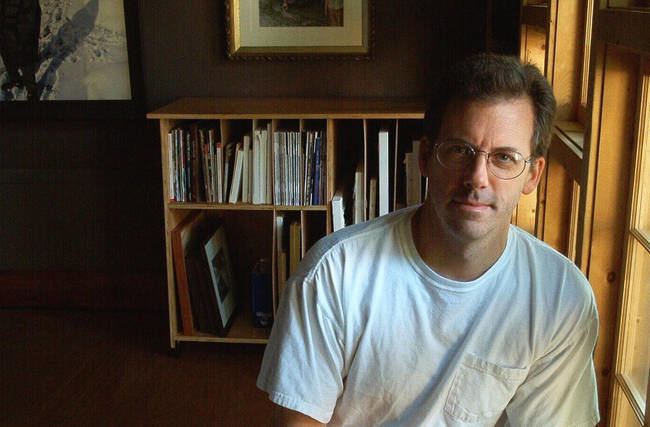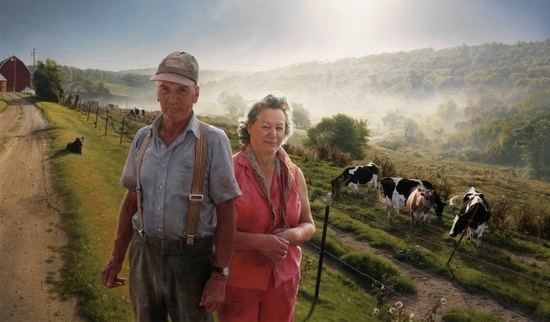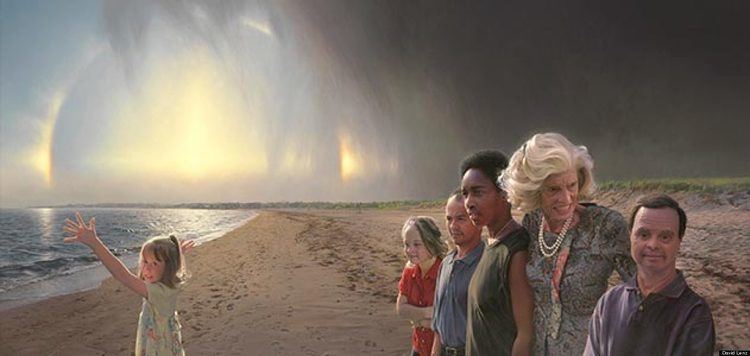Name David Lenz | Role Artist | |
 | ||
Changemaker david lenz
David Lenz (born 1962 in Milwaukee, Wisconsin) is an American portrait painter.
Contents
Since 1990 Lenz has painted intimate and highly realistic portraits of unsung Americans. Lenz is best known perhaps for winning the grand prize in the 2006 Outwin Boochever Portrait Competition. Organized by the National Portrait Gallery, part of the Smithsonian Institution, this inaugural competition attracted more than 4,000 entries from across the country. The resulting exhibition of 51 artists’ works were shown at the National Portrait Gallery from June 23, 2006 to February 19, 2007.

Lenz’s winning entry, an oil painting entitled Sam and the Perfect World depicts his son Sam, who has Down syndrome, amidst an idealized rural Wisconsin landscape.

The Arts Page | Feature | David Lenz
Biography

The grandson of painter Nic Lenz, and the son of an art dealer, Lenz received a bachelor of fine arts degree from the University of Wisconsin–Milwaukee in 1985. In the spring of 1989, after four years in publishing and advertising as an art director, Lenz left commercial art to become a full-time fine artist. At first he painted landscapes based on his travels to northern Wisconsin and Quetico Provincial Park in Ontario, Canada. These early paintings were influenced greatly by Tom Uttech, a professor at the University of Wisconsin–Milwaukee, and by the luminous light quality of Hudson River School artists Albert Bierstadt, Frederic Church, and Sanford Gifford.
After moving to the east side of Milwaukee, Lenz began to paint the neighborhoods and people of the central city. The city’s children, mostly African-American, very quickly became the focus of his paintings. In these works, completed between about 1990 to 2000, the hope and vitality of the children’s faces contrasts starkly with the worn down reused sidewalks, streets, and houses of the central city.
In 1999, Lenz embarked on a series of paintings depicting the lives of Wisconsin dairy farmers Ervin and Mercedes Wagner. The never-ending work of dairy farming, the toll it takes on the body, and the cultural isolation of rural life are themes of this series. Between 2000 and 2005 Lenz almost exclusively painted pictures of the Wagners and their farm. This series has been exhibited extensively in regional museums throughout the Midwest. Thistles, completed in 2001, is perhaps the most widely reproduced and celebrated painting of the Wagner Farm series.
The third area of interest for the artist, paintings depicting the lives of people with intellectual disabilities, was inspired by the birth of his son Sam, who was born with Down syndrome. Lenz contemplated the series for eight years until, in the summer of 2005, he entered the first major painting of the series in the Outwin Boochever Portrait Competition.
The work
From a short distance Lenz’s paintings appear to be strikingly realistic, even to be photographs perhaps, upon closer inspection however, they are seen to be made up of thousands of brushstrokes. Lenz starts a new painting by initially working out ideas in small pencil “thumbnail” drawings. The artist then photographs all the various elements of the image individually. These are used as the main reference material for the final painting. For a major work, he also completes an extensive array of color sketches. After the composition is fully developed, the image is drawn out carefully with pencil on a stretched canvas or board. Lenz’s painting technique is quite traditional; straight oil paint is applied using small round sable brushes over a primed and warmly tinted linen canvas.
Lenz’s subjects are people who society has taken for granted, forgotten, or overlooked. These unsung people are portrayed in an empathic way, and the extensive landscape surrounding the subjects tells much about their lives and the community beyond. Lenz incorporates various elements as metaphors to deepen the meaning of what, on the face of it, looks very straightforward and naturalistic. Sometimes Lenz takes dramatic liberties with reality, and the use of metaphors occasionally drives the scene decidedly toward the surreal.
Lenz seems to have no interest in art world trends. He paints people and places in which he feels a direct connection. One reoccurring theme in Lenz’s work is that life’s limits can be transcended with perseverance, personal heroism, and divine oversight.
In “Sam and the Perfect World,” the lush and idealistic rolling hills of Wisconsin are a metaphor for a modern civil society that values perfection. Humankind has transformed the landscape for their own use, altering this Garden of Eden, and erected a barbed wire fence; poignantly separating Sam for the rest of the world. A halo around the sun is said to represent a deity looking down upon the handwork of humankind. Without idealization or sentimentality Lenz portrays his son with an enigmatic and endearing expression, his red shirt and Oshkosh overalls giving us clues that he is like any other boy, and yet he is not. “Nevertheless,” the artist says, Sam has “something very important to say.”
Lenz is influenced by the isolated figures of Edward Hopper, the regionalist sensibility of Grant Wood, and by the symbolic meaning infused in the people and objects of Andrew Wyeth.
The Outwin Boochever Portrait Competition first place award also entitled Lenz to paint a portrait of a remarkable American for the Smithsonian National Portrait Gallery’s permanent collection. On May 9, 2009, the Gallery unveiled Lenz's historic portrait of Eunice Kennedy Shriver, the first portrait the Gallery has ever commissioned of an individual who had not been a U.S. President or First Lady. The portrait depicts Mrs. Shriver with four Special Olympics athletes and one Best Buddies participant on the beach near her Cape Cod home. In the painting from left to right are Airika Straka (Special Olympics Wisconsin), Katie Meade (Best Buddies Iowa), Andy Leonard (Special Olympics Ohio), Loretta Claiborne (Special Olympics Pennsylvania), Mrs. Shriver, and Marty Sheets (Special Olympics North Carolina).
In 2010, his commission "Wishes in the Wind", depicting three disadvantaged Milwaukee children blowing soap bubbles, was hung in the Wisconsin Governor's Mansion. In 2011, newly elected Wisconsin Governor Scott Walker removed the painting and replaced it with a 140-year-old portrait of Old Abe the War Eagle. She is the most famous of all Civil War mascots.
Awards
Besides winning the grand prize in the 2006 Outwin Boochever Portrait Competition, Lenz also was included in the 2006 Midwest Edition of New American Paintings. In 2008, Lenz was awarded a Wisconsin Visual Art Lifetime Achievement Award, and in 2009 he was inducted as a fellow of the Wisconsin Academy of Sciences, Arts and Letters.
